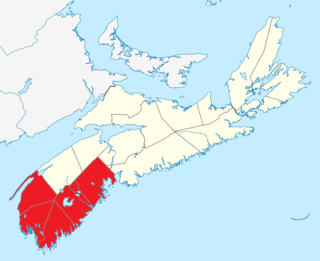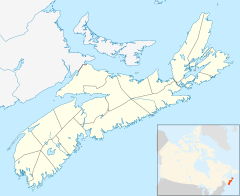The Aspotogan Peninsula is a peninsula in the eastern part of Lunenburg County, Nova Scotia, separating St. Margarets Bay in the east from Mahone Bay in the west. The peninsula was originally settled by second generation French immigrants on the east side and by second generation German immigrants on the west side. Traditionally fishing was a major industry for communities throughout the peninsula, however other primary industries such as farming and forestry were historically important as well. Shipping and shipbuilding were secondary and tertiary industries that also came into prominence during the 19th and early 20th centuries.
The Lighthouse Route is a scenic roadway in the Canadian province of Nova Scotia. It follows the province's South Shore for 585 km (364 mi) from Halifax to Yarmouth.

The Municipality of the District of Chester is a Nova Scotia district municipality occupying the northeastern half of Lunenburg County, Canada.
New Germany is a village in Lunenburg County, Nova Scotia, Canada. Located along the LaHave River and New Germany Lake it is a main service centre connecting Bridgewater and Middleton via highway Trunk 10. New Germany is situated 25 kilometres north of Bridgewater and 64 kilometres south of Middleton Annapolis Valley. It has a population of 447 as of the 2021 census.

Waterloo, Nova Scotia, Canada is a small rural community in western Lunenburg County, Nova Scotia. The community extends approximately 10 kilometers from Route 210 to the Queens County line and is 20 kilometers from the commercial hub of Bridgewater. The Waterloo Road runs through the community providing a picturesque alternative to Route 210 when travelling between Newcombville and Greenfield.

The St. Croix River is a river in Nova Scotia entirely contained in Hants and Halifax Counties. Its headwaters are Panuke Lake. The river has been exploited for water power. There were water mills in the nineteenth century and in the 1930s three hydroelectric dams were built; they still operate.
Mill Cove is a community in the Canadian province of Nova Scotia, located in the Chester Municipal District on the Aspotogan Peninsula on the Lighthouse Route. The community was home to CFS Mill Cove from 1967 til the 1990s.
Blockhouse is a community in the Canadian province of Nova Scotia, located in the Lunenburg Municipal District in Lunenburg County. It was named after the blockhouses constructed by Captain Ephraim Cook to protect colonists following a raid in 1756. The final blockhouse in the community burned down in 1874.
Conquerall Mills is a community in the Canadian province of Nova Scotia, located in the Lunenburg Municipal District in Lunenburg County near Bridgewater and Conquerall Bank which are located on the shore of LaHave River. Conquerall Mills is dominated by Fancy Lake which is the source for the picturesque Petite Rivière. Fancy Lake is home to small mouth bass and the invasive species of chain pickerel. There are warnings against fishing the endangered Atlantic White fish which are rumoured to exist in the Fancy Lake/Petite Rivière system. The community is 125 kilometers southwest of Halifax.
Dayspring is a community in the Canadian province of Nova Scotia, located on the banks of the Lahave River in the Lunenburg Municipal District in Lunenburg County. It is home to the traditional wooden shipyard, Snyder's Shipyard, builders of Theodore Too, among many other vessels, as well as The Riverview Enhanced Living Centre, Miller's Point Peace Park, the Municipal Activity and Recreation Complex and the Bridgewater/Dayspring Airpark.
Mader's Cove is a community in the Canadian province of Nova Scotia, located in the Lunenburg Municipal District in Lunenburg County. The current area is mostly along the Mader's Cove Road along the waters of Mahone Bay and includes Westhaver Beach. It is bounded on the west by the old railway, now part of the Bay to Bay Trail, that runs along the old number 3 Highway.
Upper New Cornwall is a community in the Canadian province of Nova Scotia, located in the Lunenburg Municipal District in Lunenburg County.
Broad Cove is a community in the Canadian province of Nova Scotia, located in the Lunenburg Municipal District in Lunenburg County.
Lake Centre is a community in the Canadian province of Nova Scotia, located in the Lunenburg Municipal District in Lunenburg County.
Lake William is a community in the Canadian province of Nova Scotia, located in the Lunenburg Municipal District in Lunenburg County.
Cornwallis Township was one of the original townships of Kings County, Nova Scotia. The township was named after Edward Cornwallis, the founder of Halifax, Nova Scotia. It bordered Aylesford Township to the west and Horton Township to the south. While the name has fallen into disuse on maps, overshadowed by the growth of individual towns and villages within the township, many historical places and documents refer to Cornwallis. The Parish of Cornwallis, however, is still in use today by several churches after more than 250 years.
There are various Black Lakes in Nova Scotia, Canada. They vary widely in size, depth and usability. Many counties, such as Cumberland, Halifax, Inverness, and Pictou Counties have more than one Black Lake so named, while other counties mentioned in this article have only one named Black Lake.

The Raid on Lunenburg occurred during the French and Indian War when Mi'kmaq and Maliseet fighters attacked a British settlement at Lunenburg, Nova Scotia on May 8, 1756. The native militia raided two islands on the northern outskirts of the fortified Township of Lunenburg, Rous Island, and Payzant Island. According to French reports, the Raiding party killed twenty settlers and took five prisoners. This raid was the first of nine the Natives and Acadians would conduct against the peninsula over a three-year period during the war. The Wabanaki Confederacy took John Payzant and Lewis Payzant prisoner, both of whom left written account of their experiences.

Southern Nova Scotia or the South Shore is a region of Nova Scotia, Canada. The area has no formal identity and is variously defined by geographic, county and other political boundaries. Statistics Canada, defines Southern Nova Scotia as an economic region, composed of Lunenburg County, Queens County, Shelburne County, Yarmouth County, and Digby County. According to Statistics Canada, the region had the highest decrease of population in Canada from 2009 to 2010, with a population decrease of 10.2 residents per thousand. The region also has the second-highest median age in Canada at 47.1 years old.

A township in Nova Scotia, Canada, was an early form of land division and local administration during British colonial settlement in the 18th century. They were created as a means of populating the colony with people loyal to British rule. They were typically rural or wilderness areas of around 100,000 acres (400 km2) that would eventually include several villages or towns. Some townships, but not all, returned a member to the General Assembly of Nova Scotia; others were represented by the members from the county. Townships became obsolete by 1879 by which time towns and counties had become incorporated.






